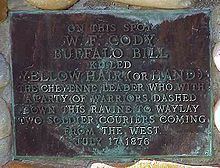~200-300 ~350 Date 17 July 1876 | 1 killedunknown wounded none | |
 | ||
Similar Battle of Mud Springs, Battle of Rush Creek, Battle of Wolf Mountain, Great Sioux War of 1876, Battle of Powder River | ||
The Battle of Warbonnet Creek was a skirmish characterized by a duel between "Buffalo Bill" Cody and a young Cheyenne warrior named Heova'ehe or Yellow Hair (often incorrectly translated as "Yellow Hand"). The engagement is often referred to as the First Scalp for Custer because of this incident. It occurred July 17, 1876, in Sioux County in northwestern Nebraska.
Contents
Background
After the defeat of George A. Custer at the Battle of Little Bighorn, many Native Americans joined with Sitting Bull and Crazy Horse, encouraged by the Indians' success. About 200-300 Cheyenne warriors led by Morning Star (also known as Dull Knife) set out with their families from the Spotted Tail and Red Cloud agencies in Nebraska.
The United States Army had sent the U.S. 5th Cavalry Regiment, commanded by Lieutenant Colonel Eugene Asa Carr, from Oklahoma to a position on the Cheyenne River in South Dakota to guard against such an occurrence. Carr was replaced in command on July 1 by Colonel Wesley Merritt, and when news of the Battle of the Little Big Horn reached General George Crook on July 5, the 5th Cavalry was ordered to reinforce Crook on Goose Creek in Wyoming.
Engagement
Word of the breakout of the Cheyenne also reached Merritt, and guided by "Buffalo Bill" Cody, Merritt was able to intercept the Cheyenne warriors.
Merritt planned an ambush. He hid most of his 350 troopers inside covered wagons and posted sharpshooters nearby out of sight. Spotting Merritt's seemingly unescorted wagon train along Warbonnet Creek, a small war party of six Cheyenne warriors charged directly into the trap to divert attention from the main body of Cheyenne.
A few warriors were wounded by the troopers, but the only real action of the engagement was a "duel" between Buffalo Bill and Yellow Hair. Cody pulled his Winchester carbine and killed the Indian, then pulled out a Bowie knife and scalped him.
The main body of warriors attempted to rescue the small war party, but fled so quickly after seeing the true strength of the U.S. forces that not a single trooper was killed or injured.
Aftermath
Merritt joined Crook, whose expedition later joined with that of General Alfred H. Terry, bringing the combined strength of the U.S. force to about 4,000.
Ever the showman, Buffalo Bill returned to the stage in October, his show highlighted by a melodramatic reenactment of his duel with Yellow Hair. He displayed the fallen warrior's scalp, feather war bonnet, knife, saddle and other personal effects.
